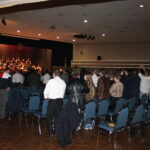Andriy Semotiuk, Toronto.
Ukrainians in the United States and elsewhere have much in common with African Americans. We can learn a lot about their shared struggle by comparing African American with Ukrainian history.
African American History in America
For over 350 years black people endured the cruelty of slavery, racism and Jim Crow laws in America. Historians have estimated that of the over 10 million Africans that fell victim to the slave trade, between 300,000 to 400,000 were brought to the United States during the 17th and 18th centuries. One source points out that, outside of the traditional count of the slave trade, an additional 500,000 Africans also came against their will, under compulsion or duress, as indentured servants, or perished on route to America. Taken together, as many as 900,000 Africans were forced in a variety of ways to come to the United States, or perished along the way.
Initially the civil war began to assert national unity against the southern secessionist Confederate states, but ultimately turned into a war to abolish slavery. President Abraham Lincoln realized that the mistreatment of black people and the abolition of slavery was a central issue for the future welfare of America. Over 600,000 American soldiers laid down their lives in what was effectively a ‘vote by the death of soldiers’ to decide what course was right for the future of America. The assassination of Lincoln was in large part the result of his effort to gain the freedom of black slaves and his support for the 13th amendment to the constitution that finally abolished slavery in 1865.
In 1868 the 14th Amendment which gave former slaves the right to vote was passed by Congress. It was left to President Ulysses S. Grant to implement the amendment and to enforce post-civil-war measures to crush the rebellions of the Ku Klux Klan and other white supremacist groups.
Despite his efforts, in the years that followed segregation flourished and racial oppression escalated across the United States. In 1909 the National Association for the Advancement of Colored People (NAACP) was formed to fight this trend. The NAACP used the federal courts to challenge disenfranchisement and residential segregation.
In 1910, job opportunities for black Americans became the primary focus of the National Urban League. However, these efforts through the courts and the political system made marginal progress. Although during World War II the integration of the armed forces helped move the cause forward, black people still remained underprivileged and racism continued largely unabated.
The valiant struggle of black people to gain their rights began heating up again in 1955 in Montgomery, Alabama when Rosa Parks refused to surrender her bus seat to a white passenger at the behest of the bus driver. On October 1st, 1962 James Meredith became the first African-American student to enroll at the all-white University of Mississippi. He did so over the objection of Mississippi Governor Ross Barnett who tried to block Meredith’s entrance on live television, proclaiming, “I’m a Mississippi segregationist and I am proud of it.” It took 30,000 U.S. troops, federal marshals and national guardsmen to get James Meredith to his classroom after a violent campus uprising. Two people were killed and more than 300 injured. But the door had opened.
The mayhem in the years that followed, included a succession of murders of black activists and freedom marches throughout the south. Several leaders heavily involved in advancing the cause of African Americans in the United States met violent deaths. President John F. Kennedy was assassinated on November 22nd, 1963. Malcom X was killed on February 21st,1965. Dr. Martin Luther King, was assassinated on April 4th, 1968 and Robert Kennedy was assassinated on June 6th, 1968. When Lyndon Johnson stepped in to replace President Kennedy, he committed himself to implementing Kennedy’s entire civil rights reform program. This included passing the Civil Rights Act of 1964 that forbade job discrimination and the segregation of public accommodations and the Voting Rights Act of 1965 that assured minority registration and voting. The struggle has continued over the years that followed. Once Barack Obama was elected as America’s first African American president in 2008 one would have thought the matter of racism against black people was finally vanquished. But no.

George Floyd
Despite these events, the status of African Americans in the United States remains tenuous and opportunities are still severely restricted. The recent spate of deaths of unarmed black men and women including the death of George Floyd reignited the simmering anger of black Americans over their mistreatment by U.S. authorities.
So What Does That Have To Do With Ukrainians?
Ukrainians, like African Americans, share a history of slavery.
From the 15th to the first half of the 17th century, about 2.5 million Ukrainians were kidnapped and rounded up to be sold into slavery in the Ottoman empire. Furthermore, until the middle of the 19th century, millions of Ukrainian serfs were considered the property of their landlords, under a feudal form of slavery, in territory controlled by Austro-Hungary, Poland and Tsarist Russia.

Ira Aldridge
The common heritage between African Americans and Ukrainians is well portrayed by the relationship between the Black American Ira Aldridge and the Ukrainian Taras Shevchenko. According to an article in the Odessa Review, “In 1858, the African American Shakespearean actor Ira Aldridge — who was playing “King Lear” and “Othello” in St. Petersburg, then the capital of Russia — met Taras Shevchenko, the Ukrainian painter, poet, political exile and spiritual leader of his nation.” Aldridge was the descendant of slaves, Shevchenko was a former serf. Their friendship is explained by reflecting on their personal histories.
Ira Frederick Aldridge, one of the first great African American theatrical actors and a descendant of slaves, was born on July 24, 1807 into the family of a preacher. Back then a black actor performing on stage shocked and infuriated the American public. It was mostly for this reason that Ira left the country of his birth and moved to London, England. He gained wide European fame for his brilliant performances in Shakespeare’s tragedies “Hamlet”, “King Lear”, “Othello” and the “The Merchant of Venice”. But even in London Ira was often subjected to persecution by racists and proponents of slavery. To escape this hostile atmosphere, he spent time in other European cities where people were less prone to judge him on the color of his skin. It was after one of his performances in St. Petersburg, Russia in 1858 that the fateful meeting between the actor and the poet Shevchenko took place. Shevchenko was so overwhelmed by Aldridge’s performance that after the play, he literally barged into the actor’s dressing room and kissed him on the cheek.
Shevchenko was much like Aldridge. Born on March 9th, 1814 in Ukraine as a peasant and a serf on the estate of a landowner, he was orphaned at the age eight. There was no one in the world he could turn to for help. Taras tried to flee, but there was nowhere to go except eventually to return to his original home where he was, once again, a serf.
His master made many trips to Kyiv, Vilna and St. Petersburg, and took Taras along to help him. While accompanying his master, Taras had an irrepressible desire to paint or, rather, to make copies of every drawing he had seen. In this way, he cultivated his artistic talent. Eventually he met Ivan Soshenko, a fellow Ukrainian and artist, who encouraged him to paint and became like a brother to him.
In 1837 Soshenko and other artists in the Academy of Fine Arts in St. Petersburg rallied together to purchase Taras’ freedom from serfdom. K. R Bryullov, a prominent artist in the Academy, painted a portrait that was sold and for 2,500 rubles. Taras Shevchenko’s freedom from serfdom was bought on April 22, 1838 with this money. He was 24 years old. From that day on, he studied at the Academy, and soon became one of Bryullov’s favorite pupils and his friend. An accomplished artist, Taras turned his talent to writing and became Ukraine’s greatest poet.
When Aldridge and Shevchenko met, they became friends, undoubtedly because in Shevchenko, Aldridge recognized a kindred spirit. Both men carried a deep understanding of the tragedy of the oppressed individual as well as that of the oppressed nation – and the knowledge of this shared pain served as a basis for their friendship. Aldridge visited Kyiv, Odessa, Kharkiv, Poltava, Zhitomir and Elizavetgrad between 1861 and 1866 and was met by an adoring public in each city.
Ira Aldridge lived to see slavery abolished in his homeland of America in December of 1865. He was so affected by this news that despite being firmly established in London, with a wife and several children, he decided to return home. Tragically, he would never make it – he died suddenly in 1867 in Poland. By that time, Shevchenko was also no longer alive. Unlike Aldridge, however, Shevchenko did not live to witness his people gain their freedom from serfdom. In a cruel twist of fate, Shevchenko died in 1861 mere days before the feudal law was revoked in the Russian Empire and serfs were freed. His dearly beloved homeland of Ukraine would only gain its independence in 1991, more than a century after the poet’s death.
Modern Parallels
During World War II in the 1940s, the Nazis took over two million workers into bondage to Germany to serve as “Ostarbeiter” slaves on estates owned by German bauers. These forced laborers taken primarily from Ukrainian lands were classified as “untermenschen” or sub-humans. The cruelties, trauma, hardships and dislocations occasioned by these forced deportations were endured by many Ukrainians who subsequently immigrated to the United States. This common history of mistreatment has never been adequately shared between the Ukrainian American and African American communities.
Unlike Ukrainians, African Americans have suffered from racism because of the color of their skin. However, similar to African Americans, Ukrainians have a long history of being the targets of prejudice and discrimination because of who they are.
Consider the prejudice that justified collective farming enforced by the Soviet Union, which really was just a modern form of feudalism. Consider the genocide against Ukrainians during the Holodomor and Russia’s attempts to Russify Ukrainians for hundreds of years by destroying their language and culture. Consider the arrests of Ukrainians by the Soviet secret police and those who were sent into exile or concentration camps in the Gulag for being Ukrainian. Consider the prejudice against the early Ukrainian pioneers in the United States and the forced internment of Ukrainians into labor camps in Canada simply for being Ukrainian. Consider the prejudice faced by those who came to America as displaced persons after World War II. Consider the 2014 Maidan Revolution of Dignity, where Ukrainians called for democratic reforms that their government was not prepared to accept. Consider the young people who were shot in the streets of Kyiv by the military police during their peaceful protests. Consider the prejudice that is now a form of hybrid warfare carried out by Putinists to divide and further weaken the Ukrainian people.
In short, prejudice and discrimination have been a historical reality for Ukrainians for centuries, so they should fight any display or cover up of it, covert or overt, isolated or systemic, subtle or blunt. For these reasons Ukrainians must understand the fear and suffering of Black America and why the death of George Floyd sparked such outrage.
What Can We Do To Help Each Other?

Dr. Martin Luther King Jr.
In terms of what can be done by both communities working together, we can either build walls and fences, buy guns and live in fear of one another, or we can adopt a creed where we care for and help one another. We can adopt the creed so well described by the late American motivational speaker Zig Ziglar, who taught us, “You can get anything you want in life, so long as you help enough other people get what they want.” We can also adopt the creed so very well presented by the late Dr. Martin Luther King Jr. in his I have a Dream speech, when he said,
“I have a dream that my four little children will one day live in a nation where they will not be judged by the color of their skin but by the content of their character. … With this faith we will be able to work together, to pray together, to struggle together, to go to jail together, to stand up for freedom together, knowing that we will be free one day … we will be able to speed up that day when all of God’s children, black men and white men, Jews and Gentiles, Protestants and Catholics, will be able to join hands and sing in the words of the old Negro spiritual, “Free at last, Free at last, Great God Almighty, “We are free at last.”
Andriy Semotiuk is a U.S. and Canadian immigration lawyer. He became an immigration lawyer because his parents were immigrants and he identified with their hardships. He is a member of the New York and California bars in the U.S., and Ontario and British Columbia bars in Canada. A former U.N. Correspondent and Tribunal Panel Member of the Canadian Human Rights Commission, Mr. Semotiuk is a published author and a professional speaker. He has helped over 10,000 clients with various legal problems and writes a column on immigration for Forbes, where over one million readers have read his articles.
Share on Social Media






































